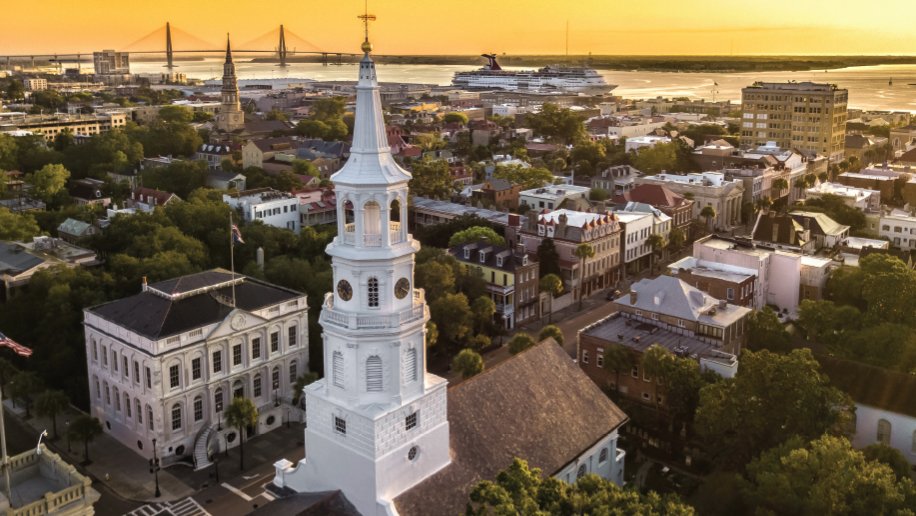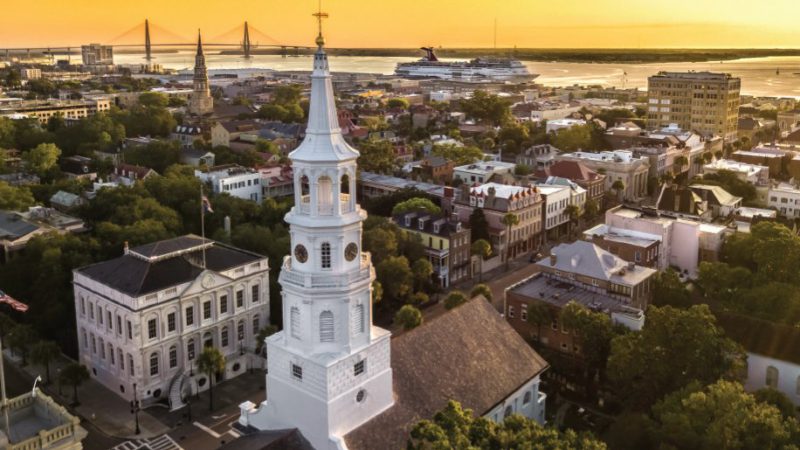Queen of the South
Charleston is very much the contemporary South – young, vibrant, tech-savvy and optimistic about the future
October 26, 2019


“In Greenville, South Carolina, they ask where you go to church. In Columbia, South Carolina, they inquire about for whom you work. In Charleston, they ask you what you want to drink,” notes Claire Gibbons, who is director of global marketing and communications for the Charleston Regional Development Alliance (CRDA), an economic development organization whose main focus is managing the remarkable growth of Charleston’s business community.
She says CRDA’s role “is to look at the supportive eco-systems that industries need to thrive. At the moment we are focusing on automotive, IT, life sciences and logistics sectors.”
She points out the key role that the young, educated workforce is playing in that growth, a fact that is confirmed in overheard conversations in the King Street bars over cocktails. Boeing, Bosch, Mahle, Blackbaud, Volvo, Mercedes-Benz, the Intertech Group – they are all here and they make up the throbbing engine of economic growth in the Charleston area.
Flying Start
Boeing opened its factory here ten years ago to build 787 Dreamliners – it is now the largest private employer in the region with around 7,000 people on staff. According to its senior director of government operations, Lindsay Leonard, what attracted the aircraft manufacturer to the region was the fact that “there is a capable and available workforce here that can be trained. We have a robust internship program and have developed training partnerships with local technical schools as well as the universities.”
A crucial component of the city’s growth and development is the Port of Charleston, the deepest harbor in the southeast. It is one of the busiest container ports in the US and during my visit it was announced that a record 215,000 containers had been loaded on to ships in a single month.
As a vivid example, every day you will see the port’s parking lot filled with glinting BMW automobiles fresh off the assembly line in Greenville, SC. Every day that parking lot empties as the vehicles are stuffed on to a container ship and sent out across the world. The following day the parking lot is full again. Over the next decade, an estimated $2 billion is to be spent upgrading the port and it remains the beating heart of commercial Charleston.
Tumultuous Times
This is unquestionably a city of Southern manners. However, while most of the executives speak of “Southern charm” as one of the main attractions of Charleston and its surrounding areas, local historian, preservationist and bespoke guide Leigh Handal warns about taking this at face value. “In the South you can say anything as ugly and cruel as you like as long as you end it with ‘bless her heart’,” she says. “Like, that’s an interesting dress – bless her heart. It’s not hypocrisy. It’s character.” Handal says the key to success in the South is to understand that character.
The city and the region’s resurgence have come after a series of historically cataclysmic reversals. In the early 19th century Charleston was the third wealthiest city in the US, but events such as the War of Independence, the American Civil War and, most significantly, the invention of the steam engine in the 1820s conspired against it. Before steam, the trade winds had taken Europe’s sailing ships to the West Indies and then, caught by the Gulf Stream, deposited them in Charleston harbor. It was the western terminus of the Great Atlantic Highway. The arrival of the steamship changed all that.
Meanwhile, rice and indigo (used in dye for British army uniforms) were principal crops that withered after the American Revolution, the latter for obvious reasons. Rice was big business and during the Colonial period coastal South Carolina was the largest producer of rice in the country as well as being one of the Western world’s top producers. It remained a dominant commodity until the end of the Civil War but by the early 1900s rice farming had all but disappeared from the state.
Decades of underperformance followed and although Charleston was a shabby-chic destination for adventurous tourists through the 20th century, its economic performance remained unimpressive. Then, in 1989, just as the city was beginning to show signs of growth, it was hit by Hurricane Hugo, the deadliest storm in its history, which killed more than 60 people and destroyed 100,000 homes across the regions it hit. The total cost of the damage was estimated at $9 billion. In the immediate aftermath, the UK’s [ital] Sunday Times [end ital] ran the headline: “Charleston, Gone With The Wind.”
Happily, nothing could have been further from the truth – with the help of a huge injection of federal relief funds, the city began its dramatic rehabilitation.
Doug Warner, director of media relations at the Charleston Area Convention and Visitors Bureau, says: “In 1989 the streetscape changed and all the older buildings got new paint jobs. Perceptions of who we were started to change and people began to develop pride in the city. In the late 1980s you couldn’t give buildings in King Street away. They were strip clubs and beer joints and many were abandoned. The Charleston renaissance began here on King Street.”
Bouncing Back
Warner says that the man who led the rebuilding was Joseph Riley, who ended up serving 40 years as mayor, the longest serving mayor in US history: “The renaissance was [down to] Riley, the response to the shooting at the Emanuel AME Church [in 2015] was Riley, and even after he left office, he remains a phenomenal leader.”
It is Riley who has been the driving force in the creation of an African-American slave museum that is planned to open on the waterfront next year. Previous generations’ attempts to sweep the slave trade under the carpet – 40 percent of those enslaved by the US entered the country through the port of Charleston – have long been abandoned and this confrontation with its inglorious past is one of the things that makes modern Charleston so compelling.
The city’s past is also littered with eccentricities and contradictions. For example, it was from the roofs of the gorgeous mansions along the East Battery foreshore that on a spring day in 1861 Charleston’s wealthy aristocrats sipped cocktails and watched the Confederate bombardment just across the water. It was the Battle of Fort Sumter in Charleston Harbor that set off the Civil War. Talk about being a witness to your own funeral… and with cocktails.
You can see the benefits of the city’s late-20th century revival as you wander through the pretty center of the downtown area, narrow streets of brightly colored clapboard houses that reminded me of the Caribbean, nestled alongside grand Georgian and Antebellum architecture. The houses and low-rise buildings on this flood-prone peninsula, known appropriately as the Lowcountry, are surrounded by three major rivers and the ocean, and so are always at risk of flooding.
Church steeples dominate the skyline as it was decreed in the 1930s that to protect the city’s architectural integrity, no building should be taller than the spire of St Matthew’s German Evangelical Lutheran Church. The elegant streets are lined with palmettos (the state tree), and magnificent oaks draped with the Spanish moss. In the private gardens that dot the city, explosions of pink, red and white camellias vie for attention with purple and red crape myrtle trees, and vivid pink oleander bushes.
Staying Power
To cater for the growth in popularity both for leisure and business visitors, there has been a boom in hotel openings, and expensive upgrades to existing properties. The top hotels are as luxurious as the best in New York and San Francisco but at half the price. Hotel Bennett on King Street is the newest, opening in February with 179 luxurious rooms, a fabulous rooftop bar and a gourmet restaurant.
One of its major rivals is a ten-minute walk along the street. The 434-room Belmond Charleston Place opened in the mid-1980s (another Riley-led initiative) and had the luxury hotel market to itself until recently. Now, smaller properties such as the 155-room Dewberry, housed in a mid-1960s federal building that had been damaged by Hurricane Hugo, and the Spectator, a stylish 41-room art deco hotel in the middle of the tourist area, have given travelers first-class options at Southern prices.
Food and Drink
Pretty soon after you arrive in the city, you will be told about the Charleston 15. Neither a sports team nor a listing of must-see historic sites, it is, rather, the number of pounds visitors can expect to gain after indulging in the city’s famous nouvelle Lowcountry cuisine.
One of the restaurants that put Charleston on the gastronomic map is Husk. Known for its wood-fire cooking, it was the first of four branches to open in the South and is rated by Diners Club as one of the World’s 50 Best Restaurants.
Hotel eateries give serious competition to standalone restaurants when it comes to fine dining – two outstanding examples are Hotel Bennett’s Gabrielle and Belmond Charleston Place’s Charleston Grill.
For fresh seafood, try the Darling Oyster Bar, where you will find the Charleston staple shrimp and grits – which should be enjoyed at least once – and 167 Raw, a tiny, casual seafood restaurant that serves lobster rolls, oysters, fish tacos and ceviche.
Lastly, the greatest contributor to the Charleston 15 has to be Rodney Scott’s BBQ, which serves the best ribs south of the Mason-Dixon Line.




